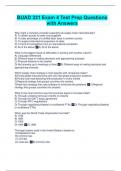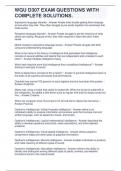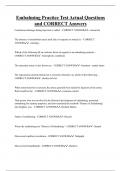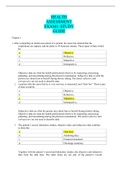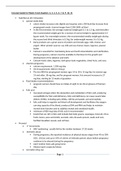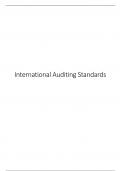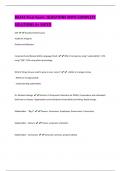Orofacial Myofunctional Disorders
1. Development and aspects related to normal eating, drinking and swallowinig
1.1. Motor Control and motor learning
- Motor control
= process of creating a sequence of movements for the performance of coordinated and
skilled actions
- Motor learning
= acquisition of skills or skilled movements as a result of practice
Every motor skill is learned through motor learning.
SENSORY INPUT
First you want to protect the lungs so the first 2 years they did not experience sensory input.
They do not know how to move food around, how to chew or how long to chew. When you
want to develop eating skills you need sensory input
Smell, taste, sight, hearing, proprioceptive and vestibular system
Sensory input!
Sensory Processing
- Stimulus registration
- Adding meaning to stimulus
For example when you walk by McDonalds
- Integration with other stimulus information
- Integration with previous sensory and motor experience
Your brain can connect what will happen when you continue to chew or what will happen
when you swallow.
- Adequate adaptive response
- Registration of response for future use
Feedback and Feedforward!
Feedback is important, but within you nervic system they will feedforward.
Motor learning and neuroplasticity = ability of the brain to change and adapt to new conditions
1.2. Development of (sensori)motor skills
- 0-3 months: Reflexes, generalized movements
- 3-4 months: Purposeful movements
- ‘Verticalization’ increased stability
You cannot spoon feeding a child that cannot sit completely vertical.
➔
- Increased mobility
Is a precondition to develop eating skills.
- Feeding skills follow
1.3. Shape and growth of oral and pharyngeal anatomic structures
Preknowledge
Infant ≠ older child
- Tongue
1
, Quite large, fills the whole cabin. Which means that that the child breathes through its nose.
There isn’t enough space to breathe through the mouth. The intention is to keep doing this
your whole life. 2 types of muscles in the tongue. There are the extrinsic muscles for elevating
and depress the base of the tongue. They also protrude and retract the tongue. There are also
intrinsic muscles, they are responsible for what shape your tongue will make. An infant
doesn’t need that much variation in shape making, so those are not that involved. When a
child grows up, this gets better. The extrinsic become less important and the intrinsic
importer.
- Fat pads/ sucking pads
A newborn has big cheeks, the cheeks has sucking pads. Is necessary in nipple feeding. You
need to create a vacuum to make the oral cavity smaller. They are also there to support the
tongue. After 4-6 months those sucking pads will vanish.
- No teeth
After 6 months the birth teeth develop. In course they dig deeper which teeth comes first, not
the most important to know by heart. Just know that after 2 years they are done and start at
6 months.
They do not need the molar to make the food disappear. So why do they come as first? They
think it’s because the sensory input.
- No true oropharynx
1.4. Physiology of eating and swallowing
Preknowledge and Dysphagia
1.5. Neurology of swallowing
Preknowledge
Dysphagia
- Appetite controlled in hypothalamus
- Regulated by hormones
• Short term: start/ end meal, appetite
• Long term: intake necessary nutrients
So infants/ children self-regulate: oral intake varies up to 30% daily!
1.6. Nutritional Requirements and growth
Child first will lose weight because it doesn’t eat much. After a week this will go better
and will drink more, the stomach will be bigger and they will gain weight.
- Amount depends on age, weight, condition, health
• Up to 3 months: 140-160 ml/ kg
• 3 months- 2 years: 100-120 ml/ kg
- Complete diet: fats, carbohydraates, protein, vitamines and trace éléments
- Growth charts :
• Length
• Weight
• Head circumference
1.7. Taste Development
- We are born with a preference for sweet foods, for high energy foods.
- Through experiences other taste preferences are learned
2
, - Breastfeeding vs bottle feeding are pretty neutral, tense more towards sweet. It has some
taste. Of course bottle feeding always has that same taste. In breastfeeding there is a little
variant, the woman can influence the taste with the food she is eating. But it does not have a
lot of influence
- Learned taste acceptance (‘the sooner the better’), because a child who was breast feeded
already learned tot taste slightly changes, they will adapt easier to new tastes.
- Disgust and rejection starts around 14 months.
It is contagious, if you hide for example broccoli under potatoes, the child will notice! And
there is the danger that it will not eat the potatoes as well because it touched the broccoli
and will not like these as well.
- Neophobic stage (fear of new foods, 20 months – 8 years)
It is best to introduce the most tastes the most early on, because there will be a period that
they will refuse new tastes or in worst cases, food they liked before.
When you start force feeding a child this can be a real feeding problem.
1.8. Food Consistency during first 18 months
When the child plays with food, you have to allow it to experiment. It is so important for the
sensory input. But ofcourse you have your limitations.
- Inherited avoidance of textures
2. Pediatric feeding disorders: General Approach
2.1. Definitio of pediatric feeding disorder
- Feeding problems
20-50% neurotypical, 80% developmental disabilities
• Food selectivity (‘picky eater’)
• Reduced appetite for or interest in food
• Slow feeding
• Food pocketing
- ‘Feeding problem’ may evolve into ‘feedinng disorder’
- PFD? Depends on the definition
- Good definition?
Unilateral Approach
ASHA ➔ Pediatric Dysphagia:
‘Impaired oral, pharyngeal and/or esophageal phases of swallowing.’
Positive aspects of AFRID:
- Incorporates nutritional complications
- Acknowledges that feeding disorders are common in certain medical conditions
3
, Problems with ARFID:
- Specifically excludes children whose primary challenge is a skill deficit
- Severity of eating disturbance must exceed that associated with comorbidity
Unifying Approach
ICF, disability and health ➔ Pediatric Feeding Disorder:
‘Impaired oral intake that is not age-appropiate and is associated with medical, nutritional,
feeding skill and/or psychosocial dysfunction.’
- Impaired oral intake: inability to consume sufficient food/liquids to meet nutritional and
hydration requirements (> 2 weeks).
- Age-appropiate ➔ children with developmental delays can be diagnosed with PFD
- Dysfunction: in 1 or more of the 4 domains
If you can explain this, you are fine. PFD evolve the 4
domains. Diagnostic criteria are in written course. The
medical dysfunction are by aspiration or by cardio respiratory
compromise. More difficult to breath and keep a normal
rhythm, signs that there is a medical feeding disorder. If the
child is not good nutrient, there is dysfunction or in children
that are too fat (food is going directly into the stomach).
When the feeding context makes that there is stress around
the table, too much stress is also a sign. The arrow show an influence. They interact.
2.2. Prevalence and groups at risk
- 1 to 10 per 1000
- Problems more common duriing first 2 years
- Groups at high risk:
• Preterm or small for gestational age
• Cardiopulmonary disease
• Genetic/chromosomal anomalies
• Craniofacial anomalies
• Neurodevelopmental disorders (CP, ASD,global developmental delay, …)
• Gastrointestinal disorders (GERD, chronic constipation, …)
• Failure to thrive (FTT)
• Hypotonia
2.3. Clinical Reasoning in PFD
Referral
- Parents concerned
- Possible questionnaire: Infant and Child Feeding Questionnaire (ICFQ)
- Consultation with pediatrician
- ‘red flags’ ➔ referral for feeding and swallowing evaluation
This is not typical in PFD: (Picture)
If there’s any doubt about aspiration, always do a test.
Anamnesis
- Medical history:
4
1. Development and aspects related to normal eating, drinking and swallowinig
1.1. Motor Control and motor learning
- Motor control
= process of creating a sequence of movements for the performance of coordinated and
skilled actions
- Motor learning
= acquisition of skills or skilled movements as a result of practice
Every motor skill is learned through motor learning.
SENSORY INPUT
First you want to protect the lungs so the first 2 years they did not experience sensory input.
They do not know how to move food around, how to chew or how long to chew. When you
want to develop eating skills you need sensory input
Smell, taste, sight, hearing, proprioceptive and vestibular system
Sensory input!
Sensory Processing
- Stimulus registration
- Adding meaning to stimulus
For example when you walk by McDonalds
- Integration with other stimulus information
- Integration with previous sensory and motor experience
Your brain can connect what will happen when you continue to chew or what will happen
when you swallow.
- Adequate adaptive response
- Registration of response for future use
Feedback and Feedforward!
Feedback is important, but within you nervic system they will feedforward.
Motor learning and neuroplasticity = ability of the brain to change and adapt to new conditions
1.2. Development of (sensori)motor skills
- 0-3 months: Reflexes, generalized movements
- 3-4 months: Purposeful movements
- ‘Verticalization’ increased stability
You cannot spoon feeding a child that cannot sit completely vertical.
➔
- Increased mobility
Is a precondition to develop eating skills.
- Feeding skills follow
1.3. Shape and growth of oral and pharyngeal anatomic structures
Preknowledge
Infant ≠ older child
- Tongue
1
, Quite large, fills the whole cabin. Which means that that the child breathes through its nose.
There isn’t enough space to breathe through the mouth. The intention is to keep doing this
your whole life. 2 types of muscles in the tongue. There are the extrinsic muscles for elevating
and depress the base of the tongue. They also protrude and retract the tongue. There are also
intrinsic muscles, they are responsible for what shape your tongue will make. An infant
doesn’t need that much variation in shape making, so those are not that involved. When a
child grows up, this gets better. The extrinsic become less important and the intrinsic
importer.
- Fat pads/ sucking pads
A newborn has big cheeks, the cheeks has sucking pads. Is necessary in nipple feeding. You
need to create a vacuum to make the oral cavity smaller. They are also there to support the
tongue. After 4-6 months those sucking pads will vanish.
- No teeth
After 6 months the birth teeth develop. In course they dig deeper which teeth comes first, not
the most important to know by heart. Just know that after 2 years they are done and start at
6 months.
They do not need the molar to make the food disappear. So why do they come as first? They
think it’s because the sensory input.
- No true oropharynx
1.4. Physiology of eating and swallowing
Preknowledge and Dysphagia
1.5. Neurology of swallowing
Preknowledge
Dysphagia
- Appetite controlled in hypothalamus
- Regulated by hormones
• Short term: start/ end meal, appetite
• Long term: intake necessary nutrients
So infants/ children self-regulate: oral intake varies up to 30% daily!
1.6. Nutritional Requirements and growth
Child first will lose weight because it doesn’t eat much. After a week this will go better
and will drink more, the stomach will be bigger and they will gain weight.
- Amount depends on age, weight, condition, health
• Up to 3 months: 140-160 ml/ kg
• 3 months- 2 years: 100-120 ml/ kg
- Complete diet: fats, carbohydraates, protein, vitamines and trace éléments
- Growth charts :
• Length
• Weight
• Head circumference
1.7. Taste Development
- We are born with a preference for sweet foods, for high energy foods.
- Through experiences other taste preferences are learned
2
, - Breastfeeding vs bottle feeding are pretty neutral, tense more towards sweet. It has some
taste. Of course bottle feeding always has that same taste. In breastfeeding there is a little
variant, the woman can influence the taste with the food she is eating. But it does not have a
lot of influence
- Learned taste acceptance (‘the sooner the better’), because a child who was breast feeded
already learned tot taste slightly changes, they will adapt easier to new tastes.
- Disgust and rejection starts around 14 months.
It is contagious, if you hide for example broccoli under potatoes, the child will notice! And
there is the danger that it will not eat the potatoes as well because it touched the broccoli
and will not like these as well.
- Neophobic stage (fear of new foods, 20 months – 8 years)
It is best to introduce the most tastes the most early on, because there will be a period that
they will refuse new tastes or in worst cases, food they liked before.
When you start force feeding a child this can be a real feeding problem.
1.8. Food Consistency during first 18 months
When the child plays with food, you have to allow it to experiment. It is so important for the
sensory input. But ofcourse you have your limitations.
- Inherited avoidance of textures
2. Pediatric feeding disorders: General Approach
2.1. Definitio of pediatric feeding disorder
- Feeding problems
20-50% neurotypical, 80% developmental disabilities
• Food selectivity (‘picky eater’)
• Reduced appetite for or interest in food
• Slow feeding
• Food pocketing
- ‘Feeding problem’ may evolve into ‘feedinng disorder’
- PFD? Depends on the definition
- Good definition?
Unilateral Approach
ASHA ➔ Pediatric Dysphagia:
‘Impaired oral, pharyngeal and/or esophageal phases of swallowing.’
Positive aspects of AFRID:
- Incorporates nutritional complications
- Acknowledges that feeding disorders are common in certain medical conditions
3
, Problems with ARFID:
- Specifically excludes children whose primary challenge is a skill deficit
- Severity of eating disturbance must exceed that associated with comorbidity
Unifying Approach
ICF, disability and health ➔ Pediatric Feeding Disorder:
‘Impaired oral intake that is not age-appropiate and is associated with medical, nutritional,
feeding skill and/or psychosocial dysfunction.’
- Impaired oral intake: inability to consume sufficient food/liquids to meet nutritional and
hydration requirements (> 2 weeks).
- Age-appropiate ➔ children with developmental delays can be diagnosed with PFD
- Dysfunction: in 1 or more of the 4 domains
If you can explain this, you are fine. PFD evolve the 4
domains. Diagnostic criteria are in written course. The
medical dysfunction are by aspiration or by cardio respiratory
compromise. More difficult to breath and keep a normal
rhythm, signs that there is a medical feeding disorder. If the
child is not good nutrient, there is dysfunction or in children
that are too fat (food is going directly into the stomach).
When the feeding context makes that there is stress around
the table, too much stress is also a sign. The arrow show an influence. They interact.
2.2. Prevalence and groups at risk
- 1 to 10 per 1000
- Problems more common duriing first 2 years
- Groups at high risk:
• Preterm or small for gestational age
• Cardiopulmonary disease
• Genetic/chromosomal anomalies
• Craniofacial anomalies
• Neurodevelopmental disorders (CP, ASD,global developmental delay, …)
• Gastrointestinal disorders (GERD, chronic constipation, …)
• Failure to thrive (FTT)
• Hypotonia
2.3. Clinical Reasoning in PFD
Referral
- Parents concerned
- Possible questionnaire: Infant and Child Feeding Questionnaire (ICFQ)
- Consultation with pediatrician
- ‘red flags’ ➔ referral for feeding and swallowing evaluation
This is not typical in PFD: (Picture)
If there’s any doubt about aspiration, always do a test.
Anamnesis
- Medical history:
4



